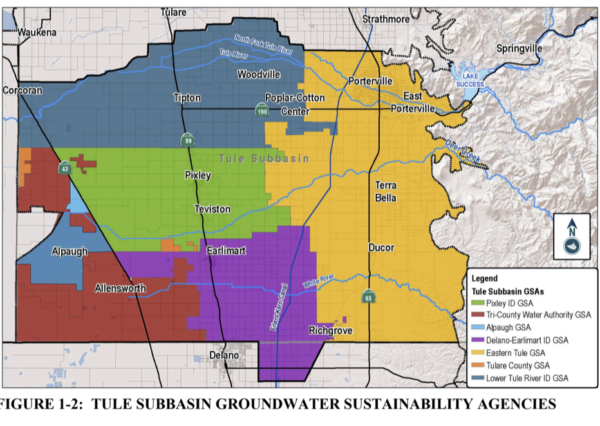San Joaquin Valley – Tule
Statistics
- Basin Name
- San Joaquin Valley – Tule
- Basin Number
- 5-022.13
- SGMA Basin Priority
- High
- Critically Overdrafted
- Yes
- Hydrologic Region Name
- Tulare Lake
- Counties
- Tulare
At-A-Glance
Located in California’s Tulare Lake hydrologic region, the San Joaquin Valley – Tule subbasin is 477,646 acres in size. This High priority basin is home to an estimated 109,471 people (2010 value). It has approximately 3396 wells, of which approximately 154 are water supply wells. Groundwater accounts for approximately 90.37 percent of the basin’s water supply.

Basin Notes
2003: Bulletin 118 basin description
2014: CASGEM basin prioritization – high. Comments: Critical aquifer overdraft conditions in basin. High nitrate and TDS in some locations and some inorganic contamination issues.
2016: Basin boundary modification accepted with San Joaquin Valley – Kern subbasin 5-022.14 Revised basin boundary description
2018: Draft priority – high. Groundwater level and subsidence comments:
- CRITICAL OVERDRAFT. 1) CASGEM/WDL/GWIDS: Longterm hydrographs show groundwater level decline. Source: DWR 2) In the Pixley area, the maximum InSAR-measured rate during 2008-2010 was 90 mm yr. Groundwater was an important part of the water supply in both areas, and pumping increased when land use changed or when surface water was less available. This increased pumping caused groundwater-level declines to near or below historical lows during the drought periods 2007-2009 and 2012-present. Source: Land subsidence in the San Joaquin Valley, California, USA, 2007–2014, M. Sneed and J.T. Brandt, Proceedings of the International Society of Hydrological Sciences, 11/12/15
- Sources: 1) Current Land Subsidence in the San Joaquin Valley, USGS; 2) 2014 – Land Subsidence from Groundwater Use in California, California Water Foundation / James W. Borchers / Michael Carpenter, Luhdorff & Salmanini, April 2014; 3) Progress Report: Subsidence in the Central Valley, California, Jet Propulsion Laboratory, California Institute of Technology, NASA 2015-16
2018: Final Basin Prioritization: Basin Priority remains unchanged at high priority.
2020: January 16: Coordination agreement between multiple Groundwater Sustainability Agencies (GSAS) producing multiple Groundwater Sustainability Plans (GSPS) for Tule Subbasin published  Tule Subbasin GSAs Groundwater Sustainability Plans:
Tule Subbasin GSAs Groundwater Sustainability Plans:
- Delano Earlimart Irrigation District GSA (January 27, 2020)
- Tri-County Water Authority (December 18, 2019)
- Eastern Tule GSA (January 17, 2020)
- Lower Tule River Irrigation District GSA (January 21, 2020)
- Pixley Irrigation District GSA, January 21, 2020
2022: January – DWR deems the collective GSA’s GSP, “the plan,” to be incomplete. Shortcomings cited include failure to define undesirable results, set minimum thresholds, or comply with GSP regulations. GSAs given 180 days to submit revised plans.
July 27 – Pixley, Eastern Tule, Delano GSAs submit revised GSPs
2023: March 2 — DWR finds the revised GSPs inadequate.
May 2 – DWR declines to receive updates for GSPs deemed inadequate and refers GSAs to the State Water Resources Control Board to avoid state intervention.
